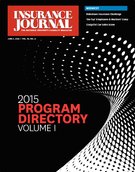Local communities, states and the insurance industry are all grappling with the issue of finding workable solutions that provide public protection while allowing for innovation and growth in new sharing, or on-demand, economy ventures like transportation network companies, short-term home rental companies and housing exchange organizations.
The ridesharing experience from an insurance perspective has been described as having three phases. Phase one is when driver is logged into a TNC application but does not have a passenger and is not matched with one. Phase two is when the driver and passenger are matched but the rider is not in the vehicle. Phase three is when the passenger has been picked up.
Because larger rideshare companies like Uber, Lyft and Sidecar provide some commercial coverage for phases two and three, phase one is the period that concerns personal auto insurers the most due to the livery exclusions in personal auto policies.
There are other points of consideration for insurers, as well.
A National Association of Insurance Commissioners (NAIC) white paper, “Transportation Network Company Insurance Principles for Legislators and Regulators,” outlines insurance considerations to help state and local policy-makers who are crafting TNC laws or regulations.
In the paper, the NAIC points out that “though the largest TNCs provide commercial coverage, those TNC’s policies may not provide the same uninsured/underinsured motorist (UM/UIM) coverage, medical payments coverage, comprehensive coverage or collision coverage that the drivers had purchased in their personal auto policies.”
The NAIC also acknowledged that many drivers are unaware that their personal auto policies exclude activities such as driving people around for a fee. And others may be aware but choose to take a chance.
Industry Response
Some say the insurance industry has been slow to respond to the needs of the growing TNC industry and other participants in these new economic models with new products.
Melissa Neis, vice president of Parr Insurance Brokerage in Chicago, said it’s probably “going to take time and experience for a lot of the mainstream carriers to jump on board on these types of new products.” But specialty agencies, like Parr Insurance, are beginning to develop programs to address the needs of the sharing economy, she said.
“What we’re seeing is specialty agencies that will build out programs specifically for a business, a shared economy business. And that’s going to be probably the model until the data is there to support pricing, especially on the homeowners side,” Neis said.
Some insurers have been entering the TNC market in small steps, however.
In November 2014, Erie Insurance in Indiana and Illinois began offering coverage for every part of the trip: before, during and after the hired ride through an endorsement to the personal auto policy that allows for business use, such as ridesharing. Erie said depending on consumer response it plans to expand the product to other states.
Neis described Erie’s ridesharing endorsement as “state of the art” and said her agency gets “phone calls for it all the time. We’re adding drivers left and right.”
Farmers, USAA, Metlife and GEICO also have developed products for a limited market that address the “gap” period for TNCs.
In addition, ISO has introduced two new personal auto coverage options for ridesharing drivers when they’re logged in but don’t have any passengers. One ISO option would apply from the time a driver logs in to the TNC platform until they’ve accepted a ride request. The other option would apply from when they log in to the TNC platform up until a passenger occupies their vehicle.
Topics Auto Personal Auto
Was this article valuable?
Here are more articles you may enjoy.


 Biden Vetoes Bid to Repeal US Labor Board Rule on Contract, Franchise Workers
Biden Vetoes Bid to Repeal US Labor Board Rule on Contract, Franchise Workers  Nuclear Verdicts Surge to $14.5 Billion in 2023 – Report
Nuclear Verdicts Surge to $14.5 Billion in 2023 – Report  Michigan Supreme Court Rules Against Couple in Drone Surveillance Case
Michigan Supreme Court Rules Against Couple in Drone Surveillance Case  Berkshire’s Jain on Cyber: ‘The Mindset Should Be You’re Not Making Money’
Berkshire’s Jain on Cyber: ‘The Mindset Should Be You’re Not Making Money’ 


